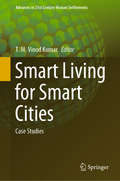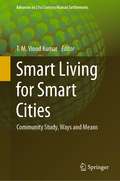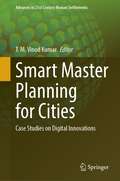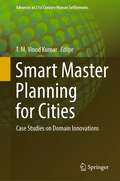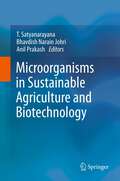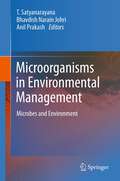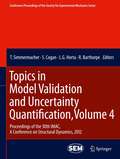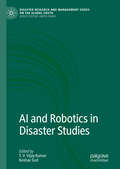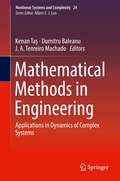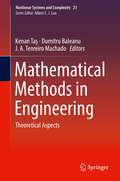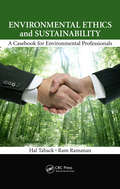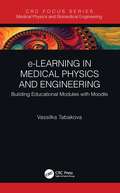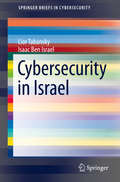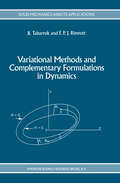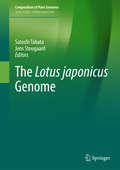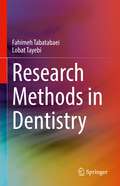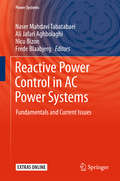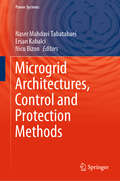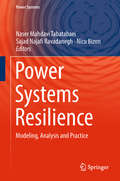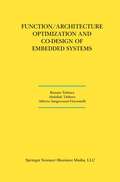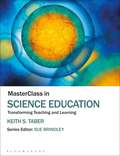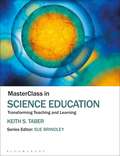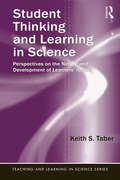- Table View
- List View
Smart Living for Smart Cities: Case Studies (Advances in 21st Century Human Settlements)
by T. M. Vinod KumarThis book, based on extensive international collaborative research, highlights the state-of-the-art design of “smart living” for metropolises, megacities, and metacities, as well as at the community and neighbourhood level. Smart living is one of six main components of smart cities, the others being smart people, smart economy, smart environment, smart mobility and smart governance. Smart living in any smart city can only be designed and implemented with active roles for smart people and smart city government, and as a joint effort combining e-Democracy, e-Governance and ICT-IoT systems. In addition to using information and communication technologies, the Internet of Things, Internet of Governance (e-Governance) and Internet of People (e-Democracy), the design of smart living utilizes various domain-specific tools to achieve coordinated, effective and efficient management, development, and conservation, and to improve ecological, social, biophysical, psychological and economic well-being in an equitable manner without compromising the sustainability of development ecosystems and stakeholders. This book presents case studies covering more than 10 cities and centred on domain-specific smart living components. The book is issued in two volumes. and this volume focus on city studies.
Smart Living for Smart Cities: Community Study, Ways and Means (Advances in 21st Century Human Settlements)
by T. M. Vinod KumarThis book, based on extensive international collaborative research, highlights the state-of-the-art design of smart living for metropolises, megacities, and metacities, as well as at the community and neighbourhood level. Smart living is one of six main components of smart cities, the others being smart people, smart economy, smart environment, smart mobility and smart governance. Smart living in any smart city can only be designed and implemented with active roles for smart people and smart city government, and as a joint effort combining e-Democracy, e-Governance and ICT-IoT systems. In addition to using information and communication technologies, the Internet of Things, Internet of Governance (e-Governance) and Internet of People (e-Democracy), the design of smart living utilizes various domain-specific tools to achieve coordinated, effective and efficient management, development, and conservation, and to improve ecological, social, biophysical, psychological and economic well-being in an equitable manner without compromising the sustainability of development ecosystems and stakeholders. This book presents case studies covering more than 10 cities and centred on domain-specific smart living components. The book is issued in two volumes and this volume focus on community studies and ways and means.
Smart Master Planning for Cities: Case Studies on Digital Innovations (Advances in 21st Century Human Settlements)
by T. M. Vinod KumarThis book, based on international collaborative research, presents a state-of-the-art design for “Smart Master Planning” for all metropolises, megacities and metacities as well as at subcity zonal and community and neighborhood level. Smart Master Planning accepts that all cities are a smart city in making in a limited way as far as the six components for smart cities, namely smart people, smart economy, smart environment, smart mobility and smart governance are concerned. Smart Master Planning in any city can only be designed and executed by active roles of smart people and smart city government and is a joint and synchronous effort of e-democracy, e-governance and ICT-IOT system in a 24 hour 7-day framework on all activities. In addition to use of information and communication technologies and remote sensing, the design of Smart Master Planning utilizes domain-specific tools of many aspects of a city to realize the coordinated, effective and efficient planning, management, development and conservation that improve ecological, social, biophysical, psychological and economic wellbeing in an equitable manner without compromising the sustainability of development ecosystems and stakeholders. This book will present 12 case studies covering more than 12 cities or more cities centered on domain-specific smart planning components.Case studies of digital innovations in the Smart Master Planning include Application of Artificial Neural Network in Master Planning for cities, Smart Master Plan and 3 D GIS Planning Support System and Digital Spatial Master Planning Incorporating Machine to Machine Automation for Smart Economic Community (IoT, ICT and M2M based Digital Integration).
Smart Master Planning for Cities: Case Studies on Domain Innovations (Advances in 21st Century Human Settlements)
by T. M. Vinod KumarThis book, based on international collaborative research, presents a state-of-the-art design for “Smart Master Planning” for all metropolises, megacities and meta cities as well as at sub-city zonal and community and neighborhood level. Smart Master Planning accepts that all cities are a smart city in making in a limited way as far as the six components for Smart Cities; namely, smart people, smart economy, smart environment, smart mobility and smart Governance are concerned. Smart Master Planning in any city can only be designed and executed by active roles of Smart People and Smart City Government and is a joint and synchronous effort of E-Democracy, E-Governance and ICT-IOT system in a 24 hour 7-day framework on all activities. In addition to use of Information and Communication Technologies, and Remote Sensing, the design of smart Master Planning utilizes domain specific tools of many aspects of a city to realize the coordinated, effective and efficient planning, management, development and conservation that improve ecological, social, biophysical, psychological and economic well-being in an equitable manner without compromising the sustainability of development ecosystems and stakeholders. This book will present 12 case studies covering more than 12 cities or more cities centered on domain-specific smart planning components.Case studies of Domain Innovations include Urban Land management, Master Planning for Water Management, Comprehensive Master Planning Innovations, Smart Use of Master Plan basics, Integrated Smart Master Planning, and Citizen-Centric Master Planning.
Microorganisms in Sustainable Agriculture and Biotechnology
by T. Satyanarayana and Bhavdish Narain JohriThis review of recent developments in our understanding of the role of microbes in sustainable agriculture and biotechnology covers a research area with enormous untapped potential. Chemical fertilizers, pesticides, herbicides and other agricultural inputs derived from fossil fuels have increased agricultural production, yet growing awareness and concern over their adverse effects on soil productivity and environmental quality cannot be ignored. The high cost of these products, the difficulties of meeting demand for them, and their harmful environmental legacy have encouraged scientists to develop alternative strategies to raise productivity, with microbes playing a central role in these efforts. One application is the use of soil microbes as bioinoculants for supplying nutrients and/or stimulating plant growth. Some rhizospheric microbes are known to synthesize plant growth-promoters, siderophores and antibiotics, as well as aiding phosphorous uptake. The last 40 years have seen rapid strides made in our appreciation of the diversity of environmental microbes and their possible benefits to sustainable agriculture and production. The advent of powerful new methodologies in microbial genetics, molecular biology and biotechnology has only quickened the pace of developments. The vital part played by microbes in sustaining our planet’s ecosystems only adds urgency to this enquiry. Culture-dependent microbes already contribute much to human life, yet the latent potential of vast numbers of uncultured—and thus untouched—microbes, is enormous. Culture-independent metagenomic approaches employed in a variety of natural habitats have alerted us to the sheer diversity of these microbes, and resulted in the characterization of novel genes and gene products. Several new antibiotics and biocatalysts have been discovered among environmental genomes and some products have already been commercialized. Meanwhile, dozens of industrial products currently formulated in large quantities from petrochemicals, such as ethanol, butanol, organic acids, and amino acids, are equally obtainable through microbial fermentation. Edited by a trio of recognized authorities on the subject, this survey of a fast-moving field—with so many benefits within reach—will be required reading for all those investigating ways to harness the power of microorganisms in making both agriculture and biotechnology more sustainable.
Microorganisms in Environmental Management: Microbes and Environment
by T. Satyanarayana, Bhavdish Narain Narain Johri and Anil PrakashMicrobes and their biosynthetic capabilities have been invaluable in finding solutions for several intractable problems mankind has encountered in maintaining the quality of the environment. They have, for example, been used to positive effect in human and animal health, genetic engineering, environmental protection, and municipal and industrial waste treatment. Microorganisms have enabled feasible and cost-effective responses which would have been impossible via straightforward chemical or physical engineering methods. Microbial technologies have of late been applied to a range of environmental problems, with considerable success. This survey of recent scientific progress in usefully applying microbes to both environmental management and biotechnology is informed by acknowledgement of the polluting effects on the world around us of soil erosion, the unwanted migration of sediments, chemical fertilizers and pesticides, and the improper treatment of human and animal wastes. These harmful phenomena have resulted in serious environmental and social problems around the world, problems which require us to look for solutions elsewhere than in established physical and chemical technologies. Often the answer lies in hybrid applications in which microbial methods are combined with physical and chemical ones. When we remember that these highly effective microorganisms, cultured for a variety of applications, are but a tiny fraction of those to be found in the world around us, we realize the vastness of the untapped and beneficial potential of microorganisms. At present, comprehending the diversity of hitherto uncultured microbes involves the application of metagenomics, with several novel microbial species having been discovered using culture-independent approaches. Edited by recognized leaders in the field, this penetrating assessment of our progress to date in deploying microorganisms to the advantage of environmental management and biotechnology will be widely welcomed.
Topics in Model Validation and Uncertainty Quantification, Volume 4: Proceedings of the 30th IMAC, A Conference on Structural Dynamics, 2012 (Conference Proceedings of the Society for Experimental Mechanics Series #29)
by T. Simmermacher, S. Cogan, L. G. Horta and R. BarthorpeTopics in Model Validation and Uncertainty Quantification, Volume 4, Proceedings of the 30th IMAC, A Conference and Exposition on Structural Dynamics, 2012, the fourth volume of six from the Conference, brings together 19 contributions to this important area of research and engineering. The collection presents early findings and case studies on fundamental and applied aspects of Structural Dynamics, including papers on:Robustness to Lack of Knowledge in Design Bayesian and Markov Chain Monte Carlo Methods Uncertainty Quantification Model Calibration
AI and Robotics in Disaster Studies (Disaster Research and Management Series on the Global South)
by T. V. Vijay Kumar Keshav SudThis book promotes a meaningful and appropriate dialogue and cross-disciplinary partnerships on Artificial Intelligence (AI) in governance and disaster management. The frequency and the cost of losses and damages due to disasters are rising every year. From wildfires to tsunamis, drought to hurricanes, floods to landslides combined with chemical, nuclear and biological disasters of epidemic proportions has increased human vulnerability and ecosystem sustainability. Life is not as it used to be and governance to manage disasters cannot be a business as usual. The quantum and proportion of responsibilities with the emergency services has increased many times to strain them beyond their human capacities. Its time that the struggling disaster management services get supported and facilitated by new technology of combining Artificial Intelligence (AI) and Machine Learning (ML) with Data Analytics Technologies (DAT)to serve people and government in disaster management. AI and ML have advanced to a state where they could be utilized for many operations in disaster risk reduction. Even though many disasters cannot be prevented and a number of them are blind natural disasters yet through an appropriate application of AI and ML quick predictions, vulnerability identification and classification of relief and rescue operations could be achieved.
Mathematical Methods in Engineering: Applications in Dynamics of Complex Systems (Nonlinear Systems and Complexity #24)
by Kenan Taş Dumitru Baleanu J. A. MachadoThis book presents recent developments in nonlinear dynamics with an emphasis on complex systems. The volume illustrates new methods to characterize the solutions of nonlinear dynamics associated with complex systems. This book contains the following topics: new solutions of the functional equations, optimization algorithm for traveling salesman problem, fractals, control, fractional calculus models, fractional discretization, local fractional partial differential equations and their applications, and solutions of fractional kinetic equations.
Mathematical Methods in Engineering: Theoretical Aspects (Nonlinear Systems and Complexity #23)
by Kenan Taş Dumitru Baleanu J. A. MachadoThis book collects chapters dealing with some of the theoretical aspects needed to properly discuss the dynamics of complex engineering systems. The book illustrates advanced theoretical development and new techniques designed to better solve problems within the nonlinear dynamical systems. Topics covered in this volume include advances on fixed point results on partial metric spaces, localization of the spectral expansions associated with the partial differential operators, irregularity in graphs and inverse problems, Hyers-Ulam and Hyers-Ulam-Rassias stability for integro-differential equations, fixed point results for mixed multivalued mappings of Feng-Liu type on Mb-metric spaces, and the limit q-Bernstein operators, analytical investigation on the fractional diffusion absorption equation.
Environmental Ethics and Sustainability: A Casebook for Environmental Professionals
by Hal Taback Ram RamananEnvironmental Ethics and Sustainability: A Casebook for Environmental Professionals introduces a decision-making model constructed from the viewpoint that ethics are not about the way things are, but about the way things should be. The first part of the book covers natural human instincts, human attitude, treatment of other species and the natural
e-Learning in Medical Physics and Engineering: Building Educational Modules with Moodle (Series in Medical Physics and Biomedical Engineering)
by Vassilka TabakovaThe need for qualified specialists to work with and apply sophisticated technology in contemporary medicine is rapidly growing. Professional bodies predict that meeting the needs of healthcare globally will require almost tripling the number of Medical Physicists by 2035. Similar challenges exist in the constantly growing profession of Medical Engineering. They can be solved most efficiently and effectively with the tools of e-Learning, and a free and open-source Virtual Learning Environment (VLE) platform such as Moodle is a welcome solution. The Moodle VLE platform is a free, open source learning management system that is the most popular choice for higher educational institutions worldwide. However, the best practices of the Moodle system are still unknown to many. This practical guide provides educators, programme administrators, and programme directors with a condensed guide to Moodle and step-by-step instructions on how to create a single course or an entire educational programme. It also discusses cost-effective ways to apply e-Learning in an educational institution. This guide is accessible to all professionals, even those without specialist IT skills, and will be helpful to educators of all levels in Medical Physics and Engineering, as well as in other medical and medical-related specialties or disciplines with a strong imaging component. Features: Provides step-by-step instructions of how to build a course/module for Higher Education on Moodle Gives practical solutions to implementing e-Learning in Medical Physics and Engineering Explores useful tips and tricks for best practice
e-Learning in Medical Physics and Engineering: Building Educational Modules with Moodle (Series in Medical Physics and Biomedical Engineering)
by Vassilka TabakovaThe need for qualified specialists to work with and apply sophisticated technology in contemporary medicine is rapidly growing. Professional bodies predict that meeting the needs of healthcare globally will require almost tripling the number of Medical Physicists by 2035. Similar challenges exist in the constantly growing profession of Medical Engineering. They can be solved most efficiently and effectively with the tools of e-Learning, and a free and open-source Virtual Learning Environment (VLE) platform such as Moodle is a welcome solution. The Moodle VLE platform is a free, open source learning management system that is the most popular choice for higher educational institutions worldwide. However, the best practices of the Moodle system are still unknown to many. This practical guide provides educators, programme administrators, and programme directors with a condensed guide to Moodle and step-by-step instructions on how to create a single course or an entire educational programme. It also discusses cost-effective ways to apply e-Learning in an educational institution. This guide is accessible to all professionals, even those without specialist IT skills, and will be helpful to educators of all levels in Medical Physics and Engineering, as well as in other medical and medical-related specialties or disciplines with a strong imaging component. Features: Provides step-by-step instructions of how to build a course/module for Higher Education on Moodle Gives practical solutions to implementing e-Learning in Medical Physics and Engineering Explores useful tips and tricks for best practice
Cybersecurity in Israel (SpringerBriefs in Cybersecurity)
by Lior Tabansky Isaac Ben IsraelThis SpringerBrief gives the reader a detailed account of how cybersecurity in Israel has evolved over the past two decades. The formation of the regions cybersecurity strategy is explored and an in-depth analysis of key developments in cybersecurity policy is provided.The authors examine cybersecurity from an integrative national perspective and see it as a set of policies and actions with two interconnected goals: to mitigate security risks and increase resilience and leverage opportunities enabled by cyber-space.Chapters include an insight into the planning and implementation of the National Security Concept strategy which facilitated the Critical Infrastructure Protection (CIP) agreement in 2002, (one of the first of its kind), the foundation of the Israeli Cyber-strategy in 2011, and details of the current steps being taken to establish a National Cyber Security Authority (NCSA).Cybersecurity in Israel will be essential reading for anybody interested in cyber-security policy, including students, researchers, analysts and policy makers alike.
Variational Methods and Complementary Formulations in Dynamics (Solid Mechanics and Its Applications #31)
by C. Tabarrok F.P. RimrottNot many disciplines can c1aim the richness of creative ideas that make up the subject of analytical mechanics. This is not surprising since the beginnings of analyti cal mechanics mark also the beginnings of the theoretical treatment of other physical sciences, and contributors to analytical mechanics have been many, inc1uding the most brilliant mathematicians and theoreticians in the history of mankind. As the foundation for theoretical physics and the associated branches of the engineering sciences, an adequate command of analytical mechanics is an essential tool for any engineer, physicist, and mathematician active in dynamics. A fascinating dis cipline, analytical mechanics is not only indispensable for the solution of certain mechanics problems but also contributes so effectively towards a fundamental under standing of the subject of mechanics and its applications. In analytical mechanics the fundamental laws are expressed in terms of work done and energy exchanged. The extensive use of mathematics is a consequence of the fact that in analytical mechanics problems can be expressed by variational State ments, thus giving rise to the employment of variational methods. Further it can be shown that the independent variables may be either displacements or impulses, thus providing in principle the possibility of two complementary formulations, i.e. a dis placement formulation and an impulse formulation, for each problem. This duality is an important characteristic of mechanics problems and is given special emphasis in the present book.
The Lotus japonicus Genome (Compendium of Plant Genomes)
by Satoshi Tabata Jens StougaardThis book provides insights into some of the key achievements made in the study of Lotus japonicus (birdsfoot trefoil), as well as a timely overview of topics that are pertinent for future developments in legume genomics. Key topics covered include endosymbiosis, development, hormone regulation, carbon/nitrogen and secondary metabolism, as well as advances made in high-throughput genomic and genetic approaches.Research focusing on model plants has underpinned the recent growth in plant genomics and genetics and provided a basis for investigations of major crop species. In the legume family Fabaceae, groundbreaking genetic and genomic research has established a significant body of knowledge on Lotus japonicus, which was adopted as a model species more than 20 years ago. The diverse nature of legumes means that such research has a wide potential and agricultural impact, for example, on the world’s protein production.
Research Methods in Dentistry
by Fahimeh Tabatabaei Lobat TayebiThis classroom-tested textbook will assist dental students with their academic research activities and help them to be competitive in today’s fast-growing research environment. It is designed as a core text for dental school classes such as Research Methodology and Scientific and Technical Writing, as well as Responsible Conduct of Research (RCR) training, but will also be a valuable resource for students and researchers in related fields, such as the medical sciences and biomedical engineering. The authors start the book by explaining key concepts and common approaches in dental research, both in basic science and clinical dentistry. They then familiarize readers with evidence-based research in dentistry and how to write a systematic review, explain the process of designing and presenting a proposal, discuss reporting results both in scientific and clinical research, and cover ethics in research, highlighting the significance of adherence to ethics both in animal as well as human studies.
Reactive Power Control in AC Power Systems: Fundamentals and Current Issues (Power Systems)
by Naser Mahdavi Tabatabaei Ali Jafari Aghbolaghi Nicu Bizon Frede BlaabjergThis textbook explores reactive power control and voltage stability and explains how they relate to different forms of power generation and transmission. Bringing together international experts in this field, it includes chapters on electric power analysis, design and operational strategies. The book explains fundamental concepts before moving on to report on the latest theoretical findings in reactive power control, including case studies and advice on practical implementation students can use to design their own research projects.Featuring numerous worked-out examples, problems and solutions, as well as over 400 illustrations, Reactive Power Control in AC Power Systems offers an essential textbook for postgraduate students in electrical power engineering. It offers practical advice on implementing the methods discussed in the book using MATLAB and DIgSILENT, and the relevant program files are available at extras.springer.com.
Microgrid Architectures, Control and Protection Methods (Power Systems)
by Naser Mahdavi Tabatabaei Ersan Kabalci Nicu BizonThis book presents intuitive explanations of the principles of microgrids, including their structure and operation and their applications. It also discusses the latest research on microgrid control and protection technologies and the essentials of microgrids as well as enhanced communication systems.The book provides solutions to microgrid operation and planning issues using various methodologies includingplanning and modelling;AC and DC hybrid microgrids;energy storage systems in microgrids; andoptimal microgrid operational planning.Written by specialists, it is filled in innovative solutions and research related to microgrid operation, making it a valuable resource for those interested in developing updated approaches in electric power analysis, design and operational strategies. Thanks to its in-depth explanations and clear, three-part structure, it is useful for electrical engineering students, researchers and technicians.
Power Systems Resilience: Modeling, Analysis and Practice (Power Systems)
by Naser Mahdavi Tabatabaei Sajad Najafi Ravadanegh Nicu BizonThis book presents intuitive explanations of the principles and applications of power system resiliency, as well as a number of straightforward and practical methods for the impact analysis of risk events on power system operations. It also describes the challenges of modelling, distribution networks, optimal scheduling, multi-stage planning, deliberate attacks, cyber-physical systems and SCADA-based smart grids, and how to overcome these challenges. Further, it highlights the resiliency issues using various methods, including strengthening the system against high impact events with low frequency and the fast recovery of the system properties. A large number of specialists have collaborated to provide innovative solutions and research in power systems resiliency. They discuss the fundamentals and contemporary materials of power systems resiliency, theoretical and practical issues, as well as current issues and methods for controlling the risk attacks and other threats to AC power systems. The book includes theoretical research, significant results, case studies, and practical implementation processes to offer insights into electric power and engineering and energy systems. Showing how systems should respond in case of malicious attacks, and helping readers to decide on the best approaches, this book is essential reading for electrical engineers, researchers and specialists. The book is also useful as a reference for undergraduate and graduate students studying the resiliency and reliability of power systems.
Function/Architecture Optimization and Co-Design of Embedded Systems (The Springer International Series in Engineering and Computer Science #585)
by Bassam Tabbara Abdallah Tabbara Alberto L. Sangiovanni-VincentelliFunction Architecture Co-Design is a new paradigm for the design and implementation of embedded systems. Function/Architecture Optimization and Co-Design of Embedded Systems presents the authors' work in developing a function/architecture optimization and co-design formal methodology and framework for control-dominated embedded systems. The approach incorporates both data flow and control optimizations performed on a suitable novel intermediate design task representation. The aim is not only to enhance productivity of the designer and system developer, but also to improve quality of the final synthesis outcome. Function/Architecture Optimization and Co-Design of Embedded Systems discusses the proposed function/architecture co-design methodology, focusing on design representation, optimization, validation, and synthesis. Throughout the text, the difference between behavior specification and implementation is emphasized. The current need in co-design to move from synthesis-based technology to compiler-based technology is pointed out. The authors describe and show how performing data flow and control optimizations at the high abstraction level can lead to significant size and performance improvements in both the synthesized hardware and software. The work builds on bodies of research in the silicon and software compilation domains. The aforementioned techniques are specialized to the embedded systems domain. It is recognized that guided optimization can be applied on the internal design representation, no matter what the abstraction level, and need not be restricted to the final stages of software assembly code generation, or hardware synthesis. Function/Architecture Optimization and Co-Design of Embedded Systems will be of primary interest to researchers, developers, and professionals in the field of embedded systems design.
MasterClass in Science Education: Transforming Teaching and Learning (MasterClass)
by Keith S. TaberWorried about teaching natural selection, submicroscopic particle models or circuits? Keith S. Taber explores a range of issues faced in secondary science teaching and discusses strategies for teaching the nature of scientific knowledge, making practical work effective and challenging gifted young scientists.MasterClass in Science Education shows how to become a master science teacher by developing and adopting the habits and mind-set of a teacher-as-scientist. The author introduces the three pillars of this approach: subject knowledge, pedagogic knowledge, and classroom research. The body of subject knowledge in the sciences is both vast and constantly evolving as it is challenged, updated and developed, and this text supports you to understand the dynamic nature of knowledge and the implications this has for your teaching. Taber shows how to use a knowledge-in-action approach, enacting knowledge in the complex and dynamic classroom environment. He supports you to critically examine classroom experiences, drawing on a wide-range of research-informed perspectives that offer insights into facilitating effective student learning. He also guides you to understand how to use recommendations from published research studies as components of a toolkit to improve your teaching and learning.
MasterClass in Science Education: Transforming Teaching and Learning (MasterClass)
by Keith S. TaberWorried about teaching natural selection, submicroscopic particle models or circuits? Keith S. Taber explores a range of issues faced in secondary science teaching and discusses strategies for teaching the nature of scientific knowledge, making practical work effective and challenging gifted young scientists.MasterClass in Science Education shows how to become a master science teacher by developing and adopting the habits and mind-set of a teacher-as-scientist. The author introduces the three pillars of this approach: subject knowledge, pedagogic knowledge, and classroom research. The body of subject knowledge in the sciences is both vast and constantly evolving as it is challenged, updated and developed, and this text supports you to understand the dynamic nature of knowledge and the implications this has for your teaching. Taber shows how to use a knowledge-in-action approach, enacting knowledge in the complex and dynamic classroom environment. He supports you to critically examine classroom experiences, drawing on a wide-range of research-informed perspectives that offer insights into facilitating effective student learning. He also guides you to understand how to use recommendations from published research studies as components of a toolkit to improve your teaching and learning.
Student Thinking and Learning in Science: Perspectives on the Nature and Development of Learners' Ideas (Teaching and Learning in Science Series)
by Keith S. TaberThis readable and informative survey of key ideas about students’ thinking in science builds a bridge between theory and practice by offering clear accounts from research, and showing how they relate to actual examples of students talking about widely taught science topics. Focused on secondary students and drawing on perspectives found in the international research literature, the goal is not to offer a comprehensive account of the vast literature, but rather to provide an overview of the current state of the field suitable for those who need an understanding of core thinking about learners’ ideas in science, including science education students in teacher preparation and higher degree programs, and classroom teachers, especially those working with middle school, high school, or college level students. Such understanding can inform and enrich science teaching in ways which are more satisfying for teachers, less confusing and frustrating for learners, and so ultimately can lead to both greater scientific literacy and more positive attitudes to science.
Student Thinking and Learning in Science: Perspectives on the Nature and Development of Learners' Ideas (Teaching and Learning in Science Series)
by Keith S. TaberThis readable and informative survey of key ideas about students’ thinking in science builds a bridge between theory and practice by offering clear accounts from research, and showing how they relate to actual examples of students talking about widely taught science topics. Focused on secondary students and drawing on perspectives found in the international research literature, the goal is not to offer a comprehensive account of the vast literature, but rather to provide an overview of the current state of the field suitable for those who need an understanding of core thinking about learners’ ideas in science, including science education students in teacher preparation and higher degree programs, and classroom teachers, especially those working with middle school, high school, or college level students. Such understanding can inform and enrich science teaching in ways which are more satisfying for teachers, less confusing and frustrating for learners, and so ultimately can lead to both greater scientific literacy and more positive attitudes to science.
